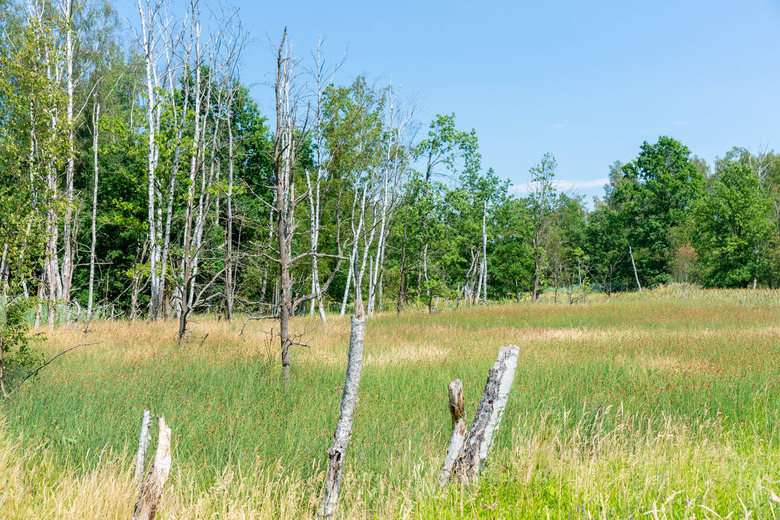Differences Between Fuller's Earth & Diatomaceous Earth
Composition is the main difference between fuller's earth and diatomaceous earth. Their differences in composition determines the differences in behavior and uses of the two substances.
TL;DR (Too Long; Didn't Read)
Fuller's earth is clay (usually montmorillonite) while diatomaceous earth is the accumulated microscopic amorphous silica skeletons of microscopic and near-microscopic aquatic photosynthetic algae called diatoms.
Composition of Fuller's Earth
Composition of Fuller's Earth
The composition of fuller's earth varies, but in general, it consists of mostly calcium montmorillonite clay. Fuller's earth also may include kaolinite and palygorskite, two additional clay minerals. In this case, clay refers to geologic mineralogy. All clays are hydrous aluminum silicates with differing impurities of potassium, sodium, calcium, magnesium or iron.
Composition of Diatomaceous Earth
Composition of Diatomaceous Earth
Diatomaceous earth consists of the shells of tiny, usually microscopic, one-celled photosynthetic algae called diatoms. Their shells are made of silica (SiO2). Diatoms live in water, so their fragile shells gradually accumulate at the bottoms of rivers, streams, lakes and oceans. If or when enough skeletons accumulate, they can be mined as diatomaceous earth. Diatomaceous earth from freshwater environments may be used without further refinement, but diatomaceous earth from seawater may need refinement to remove salt.
Uses of Fuller's Earth
Uses of Fuller's Earth
Fullers, or cleaners, used particular types of earth clay to clean Roman clothes. Similarly, the clay material used for fulling or cleaning the oils from sheep wool is called fuller's earth. These absorbing qualities make fuller's earth useful for cleaning and clarifying oils, absorbing grease and making cat litter. In addition, fuller's earth (also called multani mitti) is used in face treatments for acne and suggested as a treatment for oily hair.
Uses of Diatomaceous Earth
Uses of Diatomaceous Earth
The delicate structure of diatoms results in a very fine filter. Diatomaceous earth serves as filters but also absorbs water and oils. Diatomaceous earth acts as a pesticide because the fine dust dehydrates insects, spiders and similar pests while the sharp edges of the diatom skeletons cut the pests' exoskeletons. Diatomaceous earth appears in skin care products, toothpaste, medicines, cement, paints, foods and beverages. It is used to clarify beer and wine and to filter water, and its ability to absorb water makes it useful in cat litter. The Food and Drug Administration lists diatomaceous earth as "generally recognized as safe." To be classified as food-grade diatomaceous earth, the diatomaceous earth must be purified.
Calcined diatomaceous earth is heated above 1832 degrees Fahrenheit (1000 degrees Celsius) to harden the diatom skeletons by changing the amorphous silica to crystalline silica. This hardening improves the filtering ability of diatomaceous earth. Calcined diatomaceous earth is not considered food grade and is not used in animal feed. Crystalline silica may accumulate in lung tissue, but amorphous silica is not considered hazardous.
Cite This Article
MLA
Blaettler, Karen G. "Differences Between Fuller's Earth & Diatomaceous Earth" sciencing.com, https://www.sciencing.com/differences-fullers-earth-diatomaceous-earth-8432515/. 22 November 2019.
APA
Blaettler, Karen G. (2019, November 22). Differences Between Fuller's Earth & Diatomaceous Earth. sciencing.com. Retrieved from https://www.sciencing.com/differences-fullers-earth-diatomaceous-earth-8432515/
Chicago
Blaettler, Karen G. Differences Between Fuller's Earth & Diatomaceous Earth last modified August 30, 2022. https://www.sciencing.com/differences-fullers-earth-diatomaceous-earth-8432515/
